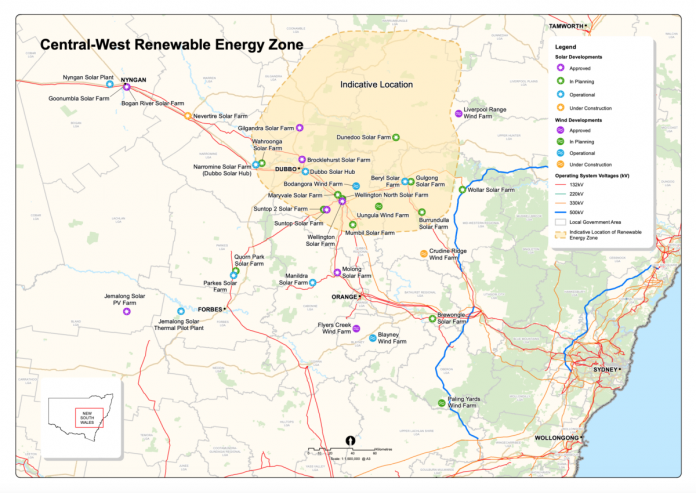The New South Wales (NSW) Government is seeking to unlock a huge pipeline of large-scale renewable energy and storage projects in the run-up to the planned retirement of its aging thermal-generation fleet. The pilot Renewable Energy Zone (REZ) in the state’s Central-West aims to deliver 3,000 MW of firmed wind and solar generation that the state government identifies as “the cheapest type of new reliable generation.”
The government has asked prospective developers to respond to a Registration of Interest until June 5, to begin consultations and coordination of new infrastructure investment in the state’s pilot REZ. Proponents of proposed, planned or operational renewable energy projects in the Central West REZ are encouraged to register their interest, while formal project proposals are not being sought at this stage.
While the NSW government expects it will take “a number of years” to design, develop and build the Central-West REZ, construction of a pilot REZ in the Central-West region is slated to begin in 2022, following extensive consultation with local communities. By mid-2020s, the government hopes to attract 3 GW of new generation capacity, worth an estimated $4.4 billion in investment.
The NSW government has a long-term plan to deliver three REZs in the state’s Central-West, New England and South-West regions, which builds on the NSW Transmission Infrastructure Strategy and supports the implementation of the Australian Energy Market Operator’s Integrated System Plan.
As of October 2019, NSW has more than 100 private sector proposals to build large renewable generators with a cumulative capacity of 17,700 MW of generation capacity, worth an estimated $24 billion of investment into regional NSW. The government’s Net Zero Plan released in March outlines the ambition to deploy all of the aforementioned capacity across the three renewable energy zones.
The state’s Central-West has been chosen as a pilot location as it already hosts a number of approved and planned projects, where the government hopes to demonstrate its coordinated approach to renewable energy deployment. The government expects to work with system planners to ensure sufficient supporting infrastructure is constructed within the state to support the Central-West REZ plans.
Just as Victoria has started withdrawing from the National Electricity Market to build its own transmission, the NSW government is pursuing its “build-it-and-they-will come” approach to transmission instead of following the RIT-T process of showing generation ready to connect, which would then justify new network infrastructure build.






